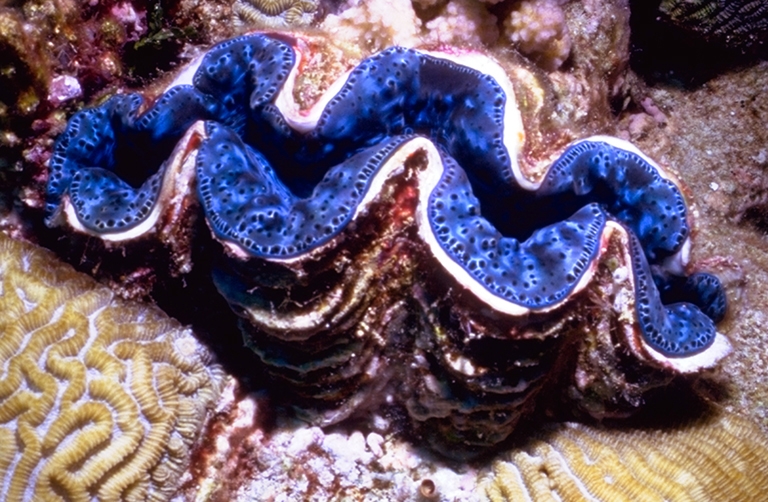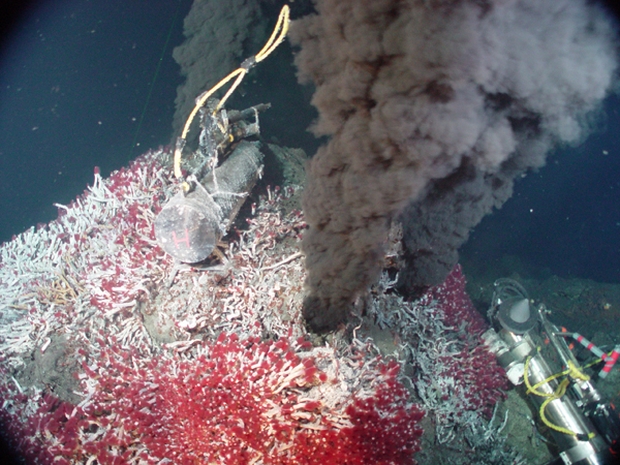In some of the ocean bed’s deepest, most inhospitable trenches, communities of creatures have evolved to live independently of energy from the sun, overturning the theory that its light and warmth are essential to survival. Instead, they are nourished from deep within the Earth. Its a world without sun.
In 1977 a team of scientists aboard the submersible Alvin were exploring the near-freezing depths of the Galapagos Rift, 240 miles (390km) north-west of the Galapagos Islands in the Pacific Ocean. They knew that in this area the tectonic plates that form the Earth’s crust are moving steadily apart at a rate of up to 8m (20cm) a year. As hot liquid lava wells up through the gap between them and reaches the cold water, it solidifies, creating new pillow-shaped clusters of rocks on the sea floor. The Alvin team found the new rocks, but at depths of up to 8600ft (2600m) below the surface of the ocean they also discovered a wonderland of extraordinary new creatures living in complete blackness.
We have an entire species, the worlds largest, that depends and survives daily through it’s reliance on the energy dispersed by the biggest star of our solar system, the Sun. Yet, there lies a ecosystem not reliant on the Sun’s energy for flourishing. This is an excerpt from the book Strange Worlds Amazing Places: A Tour of Earths Marvels and Mysteries which studies this self-sustaining ecosystem in magnificent detail.
Sunlight never penetrates to such depths in the oceans, and water pressure is more than 100 times greater than that of the air in a car tyre. Temperatures hover between 36° and 40°F (2° and 4°C) all year round. Yet in this seemingly unpromising environment are oases of warmth, where marine life forms cluster. Springs of mineral-rich water at temperatures of up to 68° (20°C) rise through crevices, or vents, in the solidified basalt of the seabed, and unique creatures that are not dependent on sunlight for their basic nourishment have developed there. Their very presence here challenges the long-field view that all life on Earth is reliant on the sun’s energy – in that green plants on land or in the sea use sunlight to convert carbon dioxide and water into food and, ultimately, all creatures depend on plants for food.
There are five distinct oasis sites in the Galapagos Rift. Four are located above fissures in the sea floor, through which spurts hot water from deep inside the Earth that has earlier filtered down through cracks in the rocky seabed. The fifth is a dead area, where temperatures are no higher than the surrounding ocean – close to freezing. The white shells of dead clams littering the gullies between the basalt pillows are the only indication that this, too, was once a hot-water oasis, but the warm water no longer flows.

Among the bizarre pillows of rock, the four warm oases nurture a multitude of creatures. Crowding the basalt are gleaming communities of giant clams, bigger than a man’s hand, with white shells and flesh scarlet with haemoglobin (the substance that colours human blood red), and also densely packed reefs of mussels. Around them scavenge hordes of blind white crabs, working by feel and smell, and small Galatheid crabs and serpulid worms that filter food from the water while limpets and tube anemones cling to the rocks. Some of the inhabitants of the depths look like no other creatures on Earth; they include animals that resemble dandelion seed heads and living spaghetti.

The most dramatic animals are giant tube worms which huddle close to the heat source. Their anatomy – white tubes that grow up to 8ft (2.5m) long, upped with blood-red fronds – holds the clue to the most exciting aspect of life in the warm-water vents. They possess neither mouth nor gut, both of which are essential to conventional digestive systems. Instead, with the help of bacteria unique to their environment, the giant tube worms absorb the oxygen, carbon dioxide and hydrogen sulphide dissolved in the water gushing from the vents through the more than 300,000 tentacles on the tips of their tubes. Dense colonies of specialized bacteria inside the worm’s body cavities convert the filtered elements (including the normally highly toxic hydrogen sulphide) into usable nutrients which are absorbed into the worms’ capillaries.

This close relationship is repeated in each of the organisms of the vent communities. The gills of mussels, for example, and the cobweb-like growths around the necks of clams both shelter the bacteria that perform the vital nutrient conversion. For this reason, scientists assume that these bacteria are the first creatures to congregate around new vents as they open up.
The teeming marine life is not the only wealth of the hot-water vents. Water seeping down through the cracks and fissures in the seabed picks up minerals and chemicals from the rocks beneath the ocean floor. As it is heated and forced back up through the vents, the water brings these minerals with it (usually in suspension, which is why the water at vent sites tends to be cloudy). Eventually, many of the minerals solidify and spread out over the seabed. Since this process is constant, and happens in the same place time and time again, the minerals have nowhere to settle but outwards and upwards, so building pillars of mineral-laden rocks up to 180ft (55m) high and 600ft (180m) across. These black smokers (so called because the water gushing up and out through their chimney is black with dissolved minerals) contain enormous concentrations of iron, zinc, barium, calcium, copper, lithium and manganese. Commercial mining of such sites may not be viable, but it is thought that they could help scientists locate similar riches on land that was once seabed.

As recently as the 1960s, the ocean floors were regarded as dark, cold, relatively lifeless deserts. The rich and varied fauna of the hydrothermal vent communities have proved that in one respect at least that assessment can no longer be considered accurate.



































